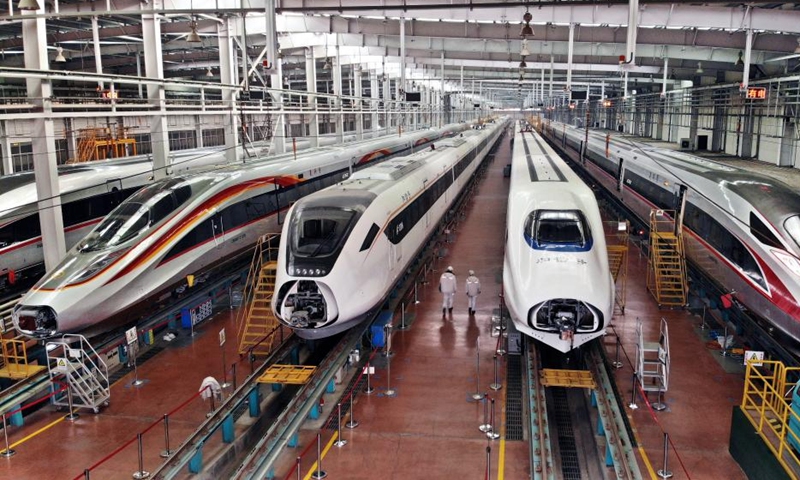2.1 billion passenger trips forecasted during 2023 Spring Festival travel rush in China

This aerial photo taken on Jan 4, 2023 shows bullets trains at a garage of CRRC Qingdao Sifang Co., Ltd. in Qingdao, east China's Shandong Province. As a major manufacturer of high-speed trains in China, CRRC Qingdao Sifang Co., Ltd. overhauled the trains that will serve the upcoming Spring Festival travel rush to ensure their smooth operation. Photo: Xinhua
China's 40-day Chunyun or Spring Festival travel rush, world's largest human migration, is expected to see about 2.09 billion passenger trips made this year, up 99.5 percent from 2022 level, as passenger volume rapidly scales up following the optimized epidemic response and amid the release of pent-up demand on people's travel, an official with China's Ministry of Transport said on Friday.
Chunyun in 2023 will last 40 days, from January 7 till February 15.
Passenger volume from air, rail and road is set to reach 70.3 percent of the pre-epidemic level in 2019, Xu Chengguang, an official responsible for the Chunyun with the MOT, told a State Council Information Office press conference on Friday.
The 2023 Chunyun officially starts on Saturday. One day later, China will begin to implement new COVID-19 response measures, which downgrades the infectious disease from Class A to Class B management, meaning travel during the Chunyun period will no longer require nucleic acid tests and health codes, while body temperature monitoring has also been scrapped.
Due to the fact that college students have already returned to their homes, this year's passenger flow will mainly be composed of those visiting relatives, which is expected to account for 55 percent of the total, according to MOT. People on their way to find jobs will account for 24 percent while those with travel and business purposes each account a further 10 percent.
As the transportation sector faces "one of the most difficult exams" amid uncertainty from an overlapping travel peak and rising COVID cases, in addition to bad weather that typically occurs during the period, the MOT said it will employ all necessary measures, including encouraging staggered peak travel, to ensure billions of Chinese people a safe and smooth journey to their homes and back to their working cities.
Xu said the 2023 Chunyun will have the most uncertainties, and will be the most complex and most challenging in recent years.

Photo:Xinhua
To cope with the challenges, the authority has encouraged staggered peak cross-region travel and called for people to reasonably plan their travel, and urged senior citizens with illness, pregnant women and children to minimize travel. Contingency plans were also systemically deployed.
The authority said it will also guide the public to be responsible for their personal health, avoiding travel with illness and wear masks and take other precaution when traveling in public transport.
Transport hardware will be checked to ensure safe operation and the ministry said operators of transport hardware should not continue work if they have fever symptoms while contactless service will be promoted on public transport.
Wan Xiangdong, from the Civil Aviation Administration of China (CAAC), the country's civil aviation regulator, said on the Friday press conference that air transportation volume is expected to return to 73 percent of the 2019 level, with the number of daily arranged passenger flights reaching 11,000.
To cope with the surge in travel demand, the CAAC said it has approved 10,313 extra flights, including 3,459 flights serving Beijing, Shanghai and Guangzhou in South China's Guangdong Province as of Thursday.
Huang Xin, an executive with the China State Railway Group Co, said the company has arranged to increase its transport capacity by 11 percent, with a maximum of more than 9 million seats available daily during the Chunyun period.
In mid-December, the national railway operator said it expected the 2023 Chunyun to reach 90 percent of the pre-epidemic level in 2019 with about 360 million passenger trips to be made.
In addition to passenger flows, an official with the State Post Bureau said the bureau has urged express delivery companies to ensure adequate staff on posts during the holidays and said it will prioritize the transport of vaccines, antigens, medicines and masks and other medical resources during the period.
A total of 94.9 percent of express delivery staff have returned to their posts as of Thursday and the express delivery business handled 16.7 percent more goods, at 1.89 billion items, for the first five days of the new year, effectively serving the economic recovery, the official said.
The MOT also expects transportation demand of energy, food as well as medical supplies and essential goods to rise "by a significant portion" during the Chunyun period, a different scenario compared with other years when cargo demand dropped.


